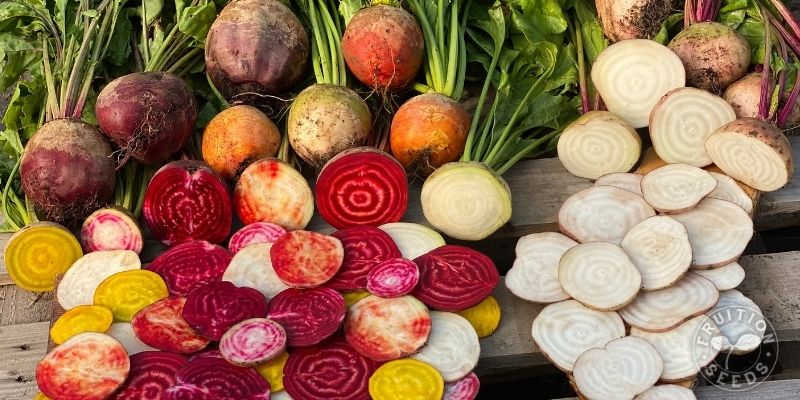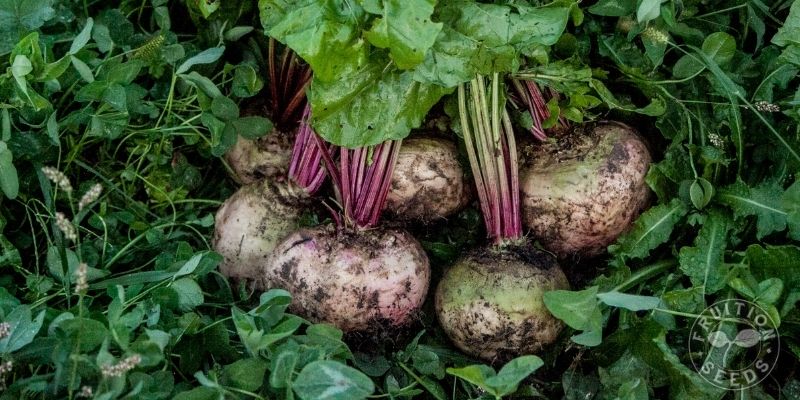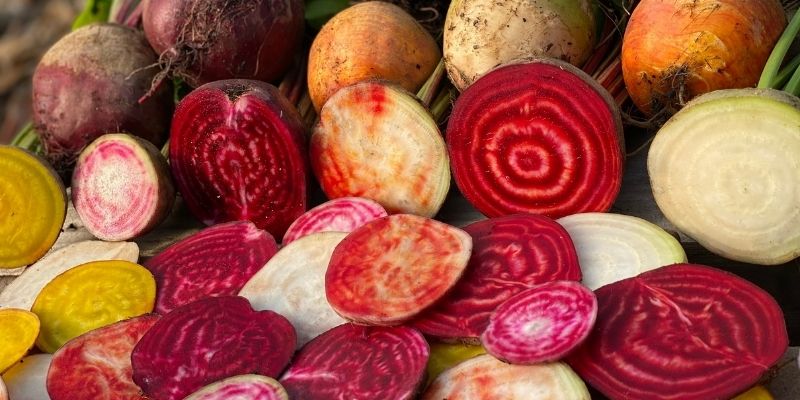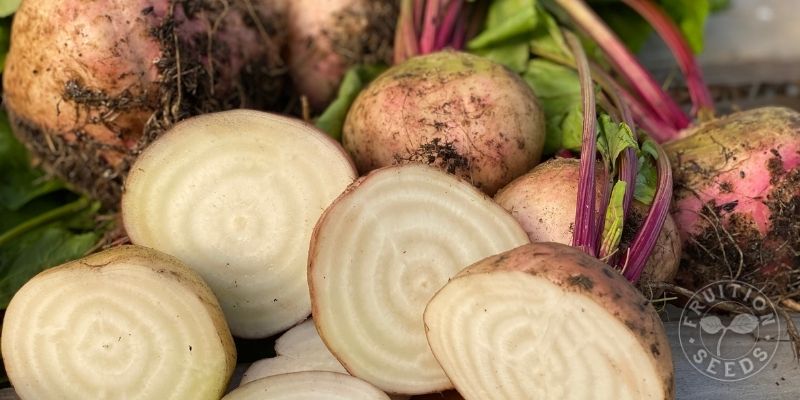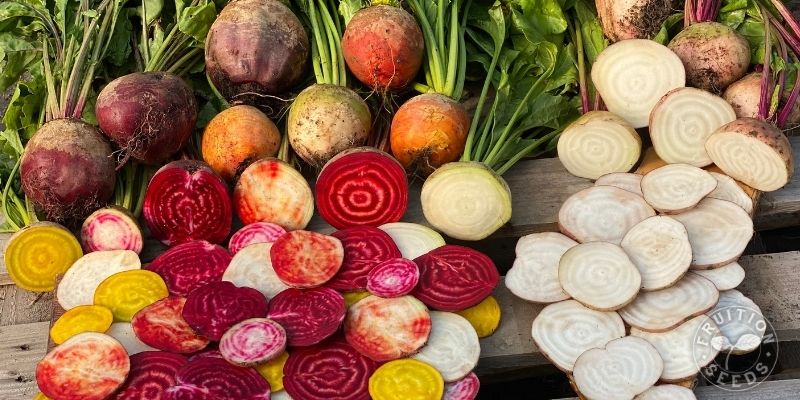By Solveig Hanson
This started as an article about beets. During my doctoral research in plant breeding and genetics, over the course of five years, I led a participatory breeding project, during which I co-selected five flavor-identified beet cultivars with farmers, chefs, and consumers in the Madison, Wisconsin area. The project started with questions about geosmin, the substance that confers earthy aroma to beets, and it ended (satisfyingly) with some answers and a new set of more complex questions. Two of the beet varieties, Blushing Not Bashful and Evansville Ember – and the questions embodied therein – are now being offered by Fruition Seeds, in Naples, NY. Listen to Solveig read this story aloud at the bottom.
Stories are inherently shaped by authors, even as authors are shaped by the events that compose their stories. So I’m going to start with the conditions under which beets and I found one another, and then describe the way we shaped one another. Beets helped me sharpen my questions, pay closer attention, measure in meaningful ways, and also relax into the complexity of growth. Beets were with me as I learned to take up space; simultaneously, I helped these particular beets to find a space in seed packets, gardens, kitchens, and mouths.
So, going back in time for a bit: Beets were my companion as soon as I started graduate school in 2015. I’d come to the University of Wisconsin from a product management position in the seed industry, before which I’d been a vegetable grower in Iowa. As a farmer, seed seemed wondrous; I was smitten with the hope and classification schemes of seed catalogs, and I loved that on my farm, seed varieties had both personalities and jobs. On my farm and later, as part of the seed industry, seed was something I’d experienced as supplied by seed companies, then bought, observed, and transformed into food on farms. Even as a product manager evaluating the performance of varieties, I didn’t know much about the transformations that had brought about the seed itself. I came to grad school to find out, and hopefully to share what I learned.

The beets that prompted this story grabbed my attention because they had been bred with flavor in mind. Specifically, these beets had been selected to be either very high or very low in geosmin, the simple twelve-carbon molecule that gives soil its distinctive earthy aroma. It’s long been known that beets have an earthy character; some people call them “dirt candy” while others say they just taste like dirt. Of the flavor components identified in beet, earthiness is the one that people most often dislike, so my doctoral advisor, Dr. Irwin Goldman (below), had wondered: If we bred a beet with less geosmin, would more people like it? And more deeply: Do beets contain geosmin because they grow in the soil, and perhaps associate with the soil microbes that are known to produce geosmin? Or do beets produce their own geosmin? Either way, can we dial geosmin up or down in beets?

When I came to the beet project, (now Dr.) Lynn Maher had uncovered some of these answers. For both high and low geosmin populations, she had carried out recurrent selection over three years. Each year, she selected the beets highest (or lowest) in geosmin and intermated them to make a new population. Sure enough, geosmin in beet was heritable, and that meant we could manipulate geosmin to create beet flavor profiles that people hadn’t experienced before. Cool! And even better, these populations were unfolding into beautiful arrays of color, as Lynn’s only selection criterion had been geosmin concentration. So I set out to ask: Will people like beets with very high or very low geosmin? Will they associate geosmin with earthiness, or with ‘signature beet flavor’? And finally: Is geosmin the characteristic that determines how much people like beets?

I decided to use a participatory plant breeding approach since it would allow us to select the beets in their target environment (organic farms in Wisconsin) using farmer input, and then engage chefs and consumers in tasting throughout the selection process. I used two participatory models, one of which involved farmers, chefs, and consumers through the UW-Madison Seed to Kitchen Collaborative, and the other of which was centered on the farmers, staff, and CSA members of Tipi Produce in Evansville, Wisconsin. These approaches make good sense, in terms of creating regionally adapted and marketable varieties, and they also make space for creativity, person-to-person learning, and (don’t tell) fun!

So I started the beet project curious and motivated…and also just starting to recover from a restrictive eating disorder that had accompanied me for most of my adult life. Food, obviously, had been at the center of my work growing vegetables, but in the midst of trying to do a lot of things right – grow vibrant, nutrient-dense food using organic methods, provide it to our local, largely rural community at affordable prices, and build authentic connections with customers – I had lost sight of my own need for nourishment. My body had become a performance art piece for the transcendence I was trying to achieve, a case study in my efforts to do more with less. When I met my beets, I was just starting to allow myself to rebuild strength, respond to hunger, embrace my needfulness, and indulge a bit.
And the beets fed me. Literally, of course, as I took home bags of ‘eaters’ from our research plots, but also in that they provided tangible evidence of iterative choice, consequence, and learning through time. For the first two cycles of selection, I eliminated beet families doing poorly in the field, and then I composed ‘beet groups’ for chefs and farm staff to taste. After they narrowed the choices to two high geosmin groups and two low geosmin groups, consumers got to choose a favorite for each geosmin class. After two cycles of selection, we’d come up with two white-rooted beets, two zoned (concentric striped) beets, and one red beet (or so we thought, take a peek at Evansville Ember’s vivid diversity!), each with defined levels of geosmin. Once the beets’ preferred appearances were set, we carried out two more breeding cycles, selecting only for horticultural traits, and we focused on characterizing the beets’ flavor.
After four seasons, the beets had changed the way they took up space. The original populations had varied in color, disease resistance, propensity to crack, ranginess or tightness of top attachment, skin smoothness, taproot taper, and more. During the course of selection, they had become varieties with defined color characteristics and much less variability in the other traits that farmers had prioritized. The beets had defined levels of geosmin, but two years of taste testing taught us that people didn’t prefer high geosmin or low geosmin beets. They also didn’t associate geosmin with earthy flavor or signature beet flavor. What people did like were sweet, non-bitter beets. Sometimes they liked beets they perceived as earthy, but those weren’t always the ones higher in geosmin. So, we had an answer: No, geosmin is not the flavor component around which beet liking is organized.
But in answering this question, the beets prompted us to ask many more. For instance, people liked the appearance of pigmented beets much more than white beets…but after tasting them, they liked the white beets (one of which would become Blushing Not Bashful) as much or more than the colored ones. This invites questions about the role of expectation in flavor perception and liking. If people expect little flavor – as is often the case with foods low in color – could the surprise of intense flavor make white beets even more pleasing? Both of this project’s white beet varieties were selected by chefs – people who craft both food and expectations around food – and I suspect that their intuition was at work here. So does breeding for flavor have as much to do with manipulating appearance as flavor compounds?
As I became better fed – by literal beets, by the (at times excessive) feast of ideas and information that graduate school offers, and by the relationships I formed over my beet-centric years – I started to take up space differently too. I realized that my undernourishment had been an effort to feel self-efficacy during very difficult life circumstances, but it was also an effort to shake off the excess privilege I could feel but not name. I felt overfed just by showing up as a white, upper-middle-class, educated person in America, and in an effort to reject my over-privilege, I rejected having what I needed.
During the time when my official work was selecting beets, learning statistics, and designing taste test experiments, my heart-work was learning how to inhabit my whole, real self. My work was learning how to stand in myself as a settler on the land I loved, as someone with an over-big footprint (due to my skin color, the choices of my ancestors, and dumb luck) but who still has needs, wants, and a whole entire body and soul to fill up while I can. I learned that I have to embrace all of the parts of myself, not because I like all of them but because they all need love. And I learned that authentic complexity is way more satisfying than attempted transcendence.

For me and my beets, the answer is that things are more complicated, more nuanced, and more delicious than binary responses will allow. The answer is that we’re still changing; the Evansville Ember didn’t stay red! The answer is, of course, to live into more questions, like: How can I inhabit my space well? How can I think about the body, home, or land I call ‘mine’ in terms of belonging rather than (or in addition to) ownership? What plants will I help to put on the land? What farming systems will they support? What imagination will they support? What relationships will they support?
It’s my honor to invite you into these beets’ stories. They are brilliant co-authors; I wish you delicious and courageous tales.
Solveig Hanson is now a postdoctoral fellow at the University of British Columbia in Vancouver, BC, where she co-manages the Canadian Organic Vegetable Improvement (CANOVI) program in collaboration with the Bauta Family Initiative on Canadian Seed Security. Solveig is presently co-writing with radicchio, rutabaga, carrot, and a wonderful team of humans; she can be reached at solveig.hanson@ubc.ca.

